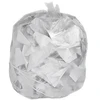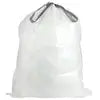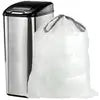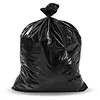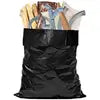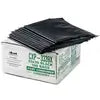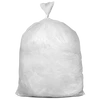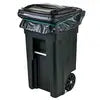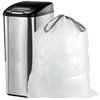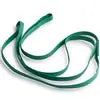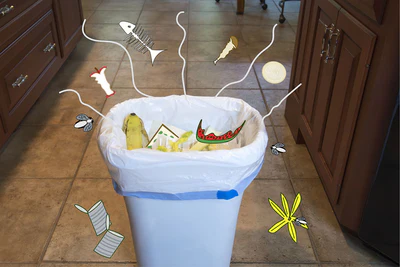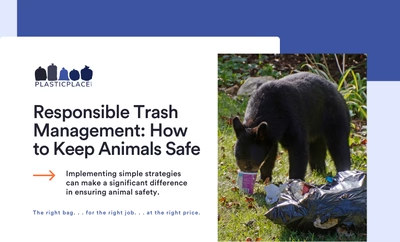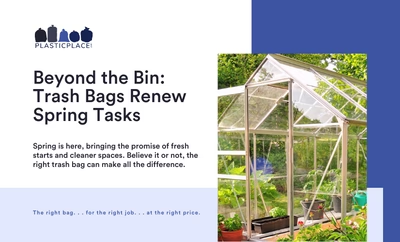Have you noticed how some trash bags easily tear while others hold heavy loads without stretching? The key isn't just the material but also the critical factor of thickness, measured in microns and mils. Understanding these measurements is crucial in choosing the right bag for the right task, whether managing kitchen waste, cleaning up on a job site, at the office, or sorting recyclables.
Let’s take a closer look at what microns and mils mean and how they determine the strength and application of trash bags. We'll review the specifics of how microns and mils make up the thickness of high-density versus low-density liners and offer practical tips for choosing between the two. By the end, you'll understand how to match bag thickness with your specific needs, ensuring your trash handling is as efficient and hassle-free as possible.
Understanding Microns and Mils
Microns
Microns are tiny! A micron, short for micrometer, is a unit of length equivalent to one-thousandth of a millimeter (.001 mm). Thickness is often measured in microns in trash bags, particularly those made from high-density polyethylene (HDPE). These bags typically range from 6.0 to 22.0 microns in thickness. To put this into perspective and help understand just how fine a micron is:
- A typical human hair is about 70 microns thick.
- A piece of paper is around 100 microns thick.
- Pollen grains can be as small as 10 microns.
Mils
On the other hand, a mil is equal to one-thousandth of an inch (.001 inch). Manufacturers commonly use this measurement for low-density polyethylene (LDPE) liners or trash bags with thicknesses ranging from 0.7 to 6.0 mils.
Here are a few examples to illustrate the concept of mils in everyday items:
- Smartphone screen protectors vary but are generally between 4 to 7 mils thick.
- A standard credit card is roughly 30 mils thick.
- A typical roll of duct tape has a thickness of about 9 to 11 mils.
Grasping the differences between microns and mils tells us about trash bag thickness, guiding you to the perfect pick for your needs. Knowing the right thickness boosts bag durability, seals out leaks, and streamlines trash management. This insight not only facilitates smarter choices but also elevates the effectiveness of your waste-handling strategy.
Thickness Matters
Now that we've unraveled the difference between microns and mils, let's explore how these measurements influence the thickness of trash bags, shaping their strength and suitability for various uses. This knowledge of high-density versus low-density liners and their respective thicknesses empowers you to select the ideal bag for any situation, ensuring the right balance of durability and functionality for your needs.
High-Density vs. Low-Density Liners
High-Density Trash Bags
It might seem the opposite, but high-density bags mean they’re often thinner. Measured in microns, they are best suited for office or bathroom waste, where sharp objects are less likely to be disposed of. Their resilience against tearing comes from their molecular structure, making them a more economical choice for lightweight trash.
- Ideal for paper waste, restroom garbage, and non-sharp kitchen refuse.
- Range from 6.0 to 22.0 microns in thickness.
Low-Density Trash Bags
In comparison, low-density trash bags can handle more. These bags, measured in mils, are thicker and more suitable for kitchen waste and construction sites where sharp, heavy, or irregular-shaped items are disposed of.
The thickness provides superior tear and puncture resistance.
- Essential for yard waste, sharp kitchen scraps, and construction debris.
- Thickness ranges from 0.7 to 6.0 mils, with kitchen bags around 0.9 mils and contractor bags starting at 3.0 mils.
Let’s Play a Game
We're setting the stage with a few scenarios to put your knowledge to the test. Given the crucial role of bag thickness depending on the waste it will contain, can you match the scenario with the ideal bag thickness? Let's dive into these real-world applications and see if you can choose the perfect bag for each job:
What bags would you choose for kitchen garbage? You're right if you chose a low-density bag that measures in mils! Low-density bags, with their thicker mil measurement, are indispensable. The likelihood of encountering sharp bones or broken glass makes the need for a sturdy bag clear. A bag thickness of around 0.9 mils to 1.5 mils offers a good balance of strength and flexibility for most kitchen needs. Use these 13-gallon trash bags in the kitchen for fewer tears and leaks.
What bag would you choose if picking up jagged debris and garbage on a construction site? Once again, low-density bags are perfect! A much thicker, low-density liner is necessary for construction debris, including sharp objects and heavy materials. These bags start at 3.0 mils and can handle the weight and sharpness of construction waste without tearing. Try the 55-60-gallon contractor bags to help you get the job done right.
Now you’re at the office. What type of bags would you pick for paper trash that gets tossed? High-five if you chose high-density bags measured in microns. High-density liners are perfect for lighter, non-sharp waste-like paper. Their thinner profile, measured in microns, can hold the weight without wasting material on unnecessary thickness. Pick up these high-quality 7-10-gallon trash bags to keep the office clutter minimal.
What about recyclables? You will want a low-density bag if you fill your recycling with cans, aluminum, and cardboard. These blue 13-gallon bags measure 1.2 mils in thickness, perfect for handling anything you plan to recycle. Their color makes them easy to identify in your cabinet and helps with sorting your garbage.
Now that you've cracked the code on microns and mils, picking the perfect trash bag for every task is a breeze. Whether it's keeping your office spotless or tackling a hefty cleanup on the construction site, this little bit of insider knowledge makes a big difference. With the right bag, you're all set to tackle waste management like a pro, blending practicality with an eye for sustainability. So, the next time you face a mess, remember that you're well-equipped to make informed choices that meet your needs perfectly.
Key Takeaways:
- Understanding Micros and Mils: Grasping the difference between microns (for lightweight office waste) and mils (for heavier kitchen and construction debris) will guide you to the best trash bag for your needs, enhancing durability and leak prevention.
- Choosing the Right Thickness: Selecting the correct thickness, whether in micros for everyday office use or mils for heavy-duty tasks, ensures your trash bags can handle the load without fail.
- Practical Application of Thickness Knowledge: With a clear understanding of micros and mils, you're equipped to choose trash bags that match the specific demands of your waste, whether it's light office paper or sharp construction remnants.
 4.9 out of 5
4.9 out of 5  Mix and Match: Buy any two products for 10% off!
Mix and Match: Buy any two products for 10% off!












